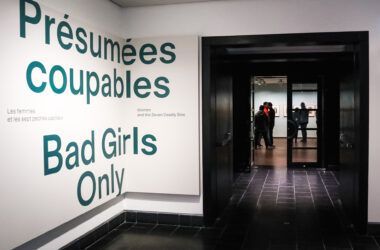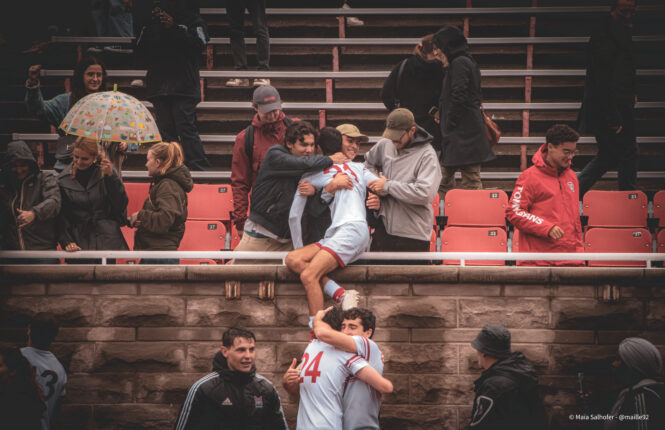In 1870, Montrealers adorned themselves with velvet and tassels and silk, and then made their way to the ball. Queen Victoria’s son, Prince Arthur—the namesake of rue Prince-Arthur—was visiting the city for the year. No expense was spared; there would be a costumed carnival, and it would be on ice. 400 of the city’s elite spent the evening gliding across the rink at the Victoria Skating Club, drinking, laughing and dancing. Mary, Queen of Scots sailed past Fra Diavolo, fat, fluffy garlands hung from the rafters, the lights were warm, colourful reflections of guests whizzing by made brushstrokes on the ice, and little Hattie Atwater—of the market, library, and station—dressed as “Fanciful Fans,” with two-dozen folding fans attached to her velvet dress, and one more on her head. And there was music—Waldteufel’s “The Skaters’ Waltz.”
There’s a man in blackface, captured in a painting of the ball. In a portrait from that night, Mr. Reynolds shows off his costume as “Quewaygoosquequamteros,” an invented Indigenous character. He posed for the photo with an axe in his mouth.
The McCord Stewart Museum’s latest exhibition, Costume Balls: Dressing Up History, 1870-1927, displays over 40 costumes from balls across Canada. Opulent and fantastical, costume balls were the apex of elite society escapism—they were, as a journalist from the Montreal Daily Witness put it, “the very acme of the phantasmagoria of the hour” (or, in the words of a fellow exhibition goer, “une grosse affaire là”).
The exhibition interrogates how the balls, though beautiful, reinforced colonial and imperial mindsets. The costumes invite viewers to be enchanted by elegance, but to ask what stories lie beneath it.
“I wanted us to present an exhibition that really had teeth,” Exhibition Curator Cynthia Cooper said in an interview with The Tribune.
Costume Balls welcomes viewers into the world of the Van Hornes and Atwaters, the Molsons and McConnells. While servants did dress up for the balls, their costumes were largely lost and many went unphotographed.
Moving through the exhibition, you hear the same music the elite danced to over a century ago, sourced from dance programs in newspapers.
“I took all the dance programs to the National Library of Canada, to the sound division, and we looked for early recordings of all these pieces [….] We were able to track down a certain number of them on records, and we made a recording of […] 20 pieces that were actually played,” Cooper said.
In the last room, the music stops. In 1896, at the Historical Fancy Dress Ball in Ottawa, Hayter Reed, “Deputy Superintendent of Indian Affairs,” led a group of guests dressed as Indigenous caricatures to the centre of the floor, “making loud noises and aggressive gestures.”
“Indian agents”—Canadian government officials sent to reserves to “manage” affairs—stole moccasins, octopus bags, and eagle feathers from Indigenous peoples to adorn the elite for lavish balls. The items were never returned and were often destroyed.
The exhibition confronts viewers with an aesthetic problem: There’s something special in seeing shoes people walked in and dresses they danced in a hundred years ago, to imagine them whirling around the room, alive and bright and brilliant, taken off and worn again. It’s heady—to see century-old photographs, and the costumes right there, stained and worn and human. It seems so real, and so beautiful, but it hides such an ugly colonial reality; gorgeous clothes dressing gruesome ideas.
There’s a blue dress in the penultimate room. Silk with a lace collar and cuffs. Cooper found that between the 1760s and 1789, the dress travelled along the path—Virginia, New York, Shelburne, Quebec City—of one of the earliest Black communities in Canada, providing insight into the lives of those who did not leave garments behind. The sartorial stories behind the pomp persist even after the clothes themselves have been lost, waiting for someone to search, to look, and to listen.
Costume Balls: Dressing Up History, 1870-1927 will run until Aug. 17, 2025. Tickets are available online or in person at the McCord Stewart Museum.









